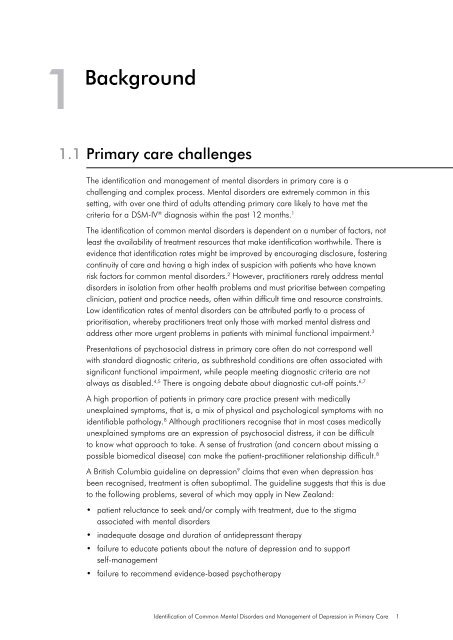Common Mental Disorders Depression - New Zealand Doctor
Common Mental Disorders Depression - New Zealand Doctor
Common Mental Disorders Depression - New Zealand Doctor
Create successful ePaper yourself
Turn your PDF publications into a flip-book with our unique Google optimized e-Paper software.
1<br />
Background<br />
1.1 Primary care challenges<br />
The identification and management of mental disorders in primary care is a<br />
challenging and complex process. <strong>Mental</strong> disorders are extremely common in this<br />
setting, with over one third of adults attending primary care likely to have met the<br />
criteria for a DSM-IV ® diagnosis within the past 12 months. 1<br />
The identification of common mental disorders is dependent on a number of factors, not<br />
least the availability of treatment resources that make identification worthwhile. There is<br />
evidence that identification rates might be improved by encouraging disclosure, fostering<br />
continuity of care and having a high index of suspicion with patients who have known<br />
risk factors for common mental disorders. 2 However, practitioners rarely address mental<br />
disorders in isolation from other health problems and must prioritise between competing<br />
clinician, patient and practice needs, often within difficult time and resource constraints.<br />
Low identification rates of mental disorders can be attributed partly to a process of<br />
prioritisation, whereby practitioners treat only those with marked mental distress and<br />
address other more urgent problems in patients with minimal functional impairment. 3<br />
Presentations of psychosocial distress in primary care often do not correspond well<br />
with standard diagnostic criteria, as subthreshold conditions are often associated with<br />
significant functional impairment, while people meeting diagnostic criteria are not<br />
always as disabled. 4,5 There is ongoing debate about diagnostic cut-off points. 6,7<br />
A high proportion of patients in primary care practice present with medically<br />
unexplained symptoms, that is, a mix of physical and psychological symptoms with no<br />
identifiable pathology. 8 Although practitioners recognise that in most cases medically<br />
unexplained symptoms are an expression of psychosocial distress, it can be difficult<br />
to know what approach to take. A sense of frustration (and concern about missing a<br />
possible biomedical disease) can make the patient-practitioner relationship difficult. 8<br />
A British Columbia guideline on depression 9 claims that even when depression has<br />
been recognised, treatment is often suboptimal. The guideline suggests that this is due<br />
to the following problems, several of which may apply in <strong>New</strong> <strong>Zealand</strong>:<br />
• patient reluctance to seek and/or comply with treatment, due to the stigma<br />
associated with mental disorders<br />
• inadequate dosage and duration of antidepressant therapy<br />
• failure to educate patients about the nature of depression and to support<br />
self-management<br />
• failure to recommend evidence-based psychotherapy<br />
Identification of <strong>Common</strong> <strong>Mental</strong> <strong>Disorders</strong> and Management of <strong>Depression</strong> in Primary Care 1

















